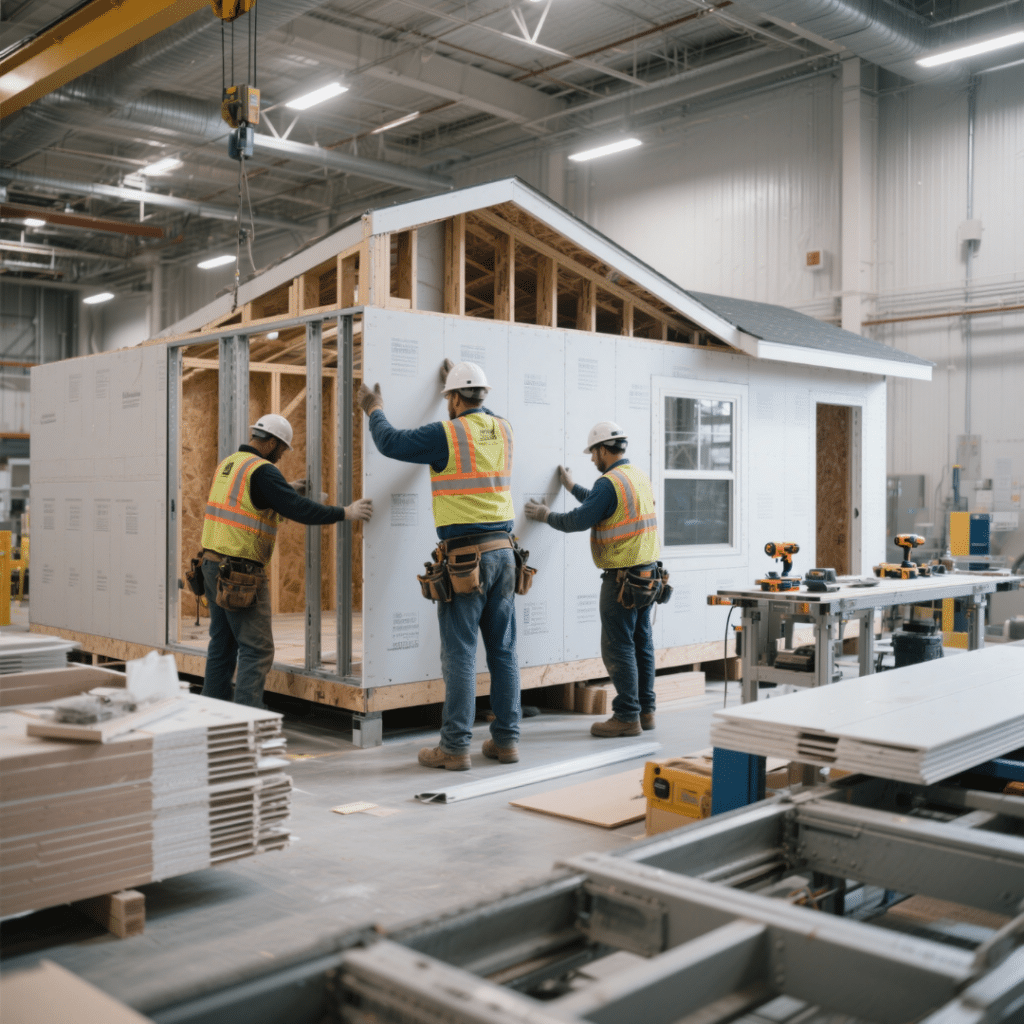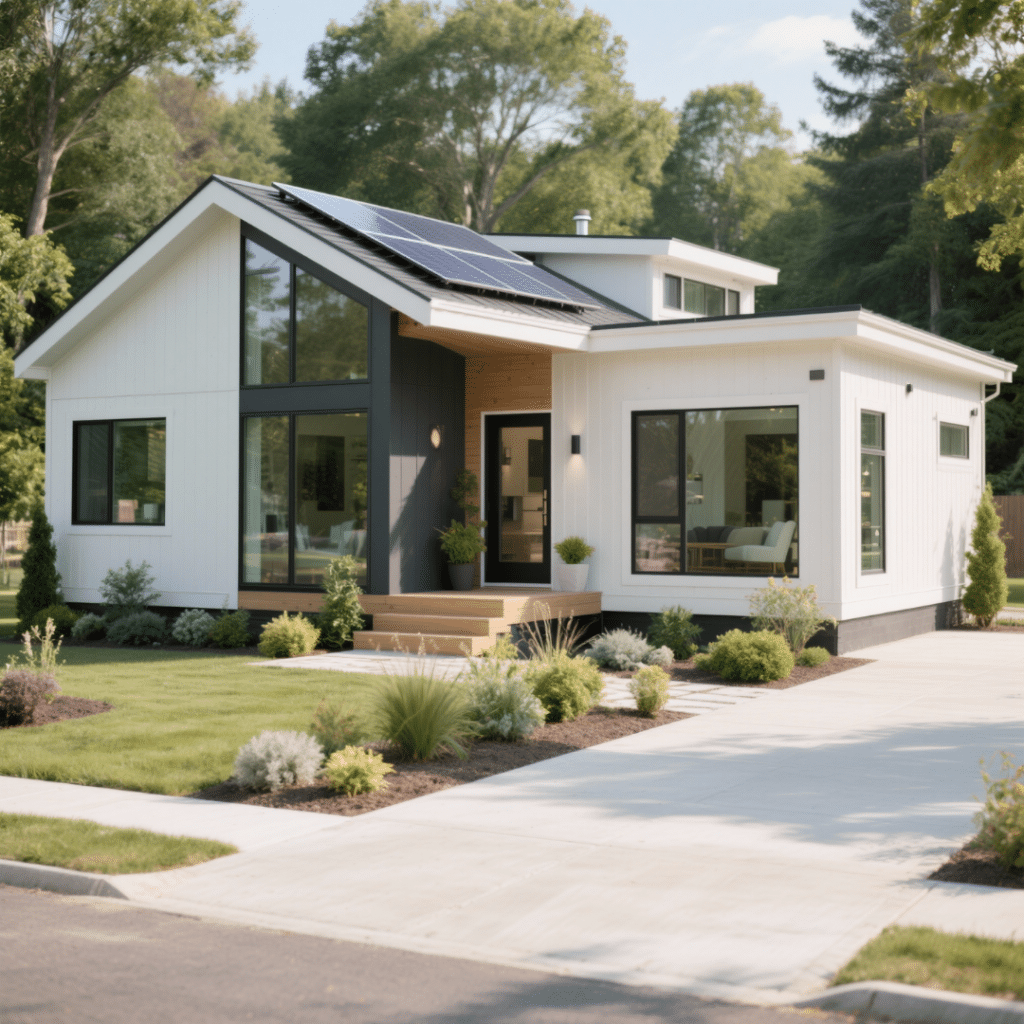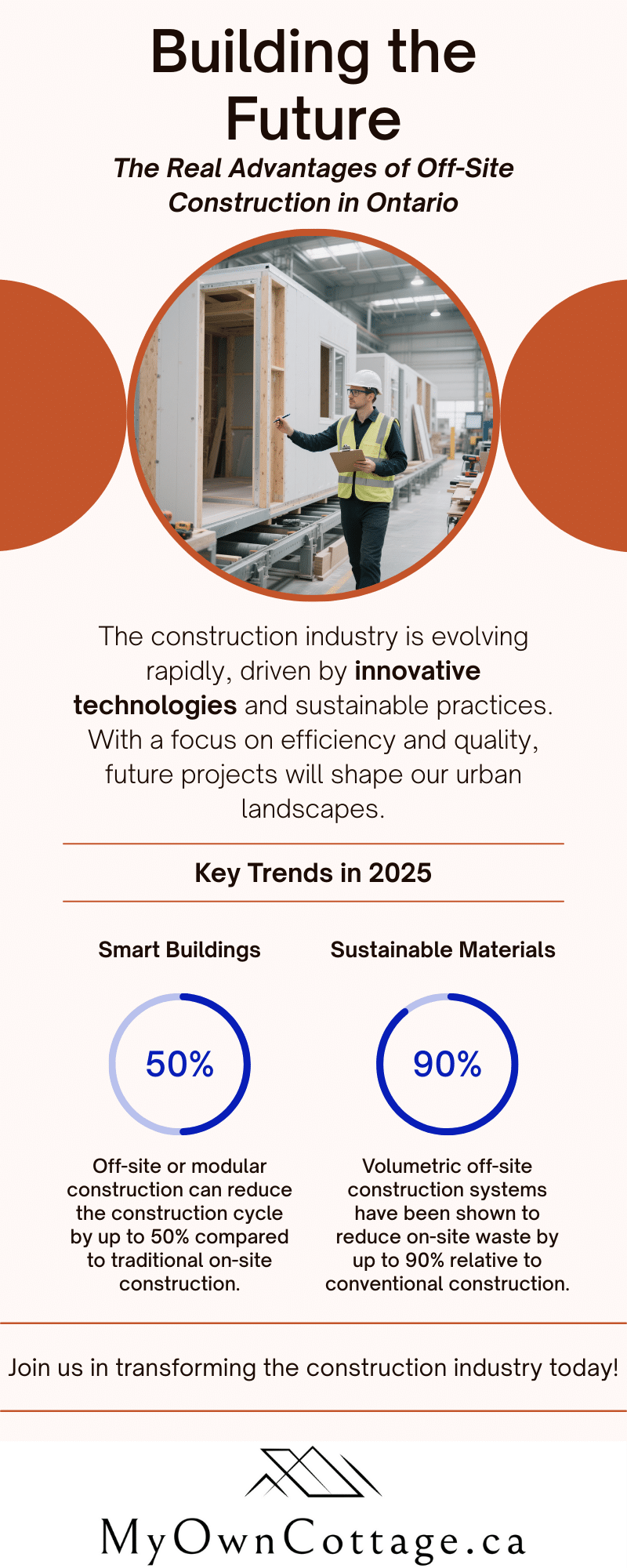Advantages of Off-Site Construction in Ontario
There are significant advantages of off-site construction in Ontario over traditional methods, including faster timelines, reduced costs, and higher quality control.
By leveraging modular building systems and sustainable practices, it delivers smarter, more efficient homes across the province.
Advantages of Off-Site Construction in Ontario: Why It’s Changing Homebuilding
The Ontario housing market is facing growing pressure from a housing shortage and rising demand for affordable homes.
To address these challenges, the construction industry is turning to off-site construction methods as a modern alternative to traditional construction methods.
Unlike conventional, onsite construction, these innovative solutions use a controlled factory environment to produce modular buildings, panelized construction, and prefabricated building elements before transporting them to the job site.
This streamlined construction process delivers significant advantages, including time savings, cost predictability, less waste, and high-quality results.

All this helps minimize the environmental impact of construction projects—making off-site methods a key driver of sustainable construction across Ontario and North America.
“Off-site construction allows us to build homes that are not only faster and more cost-efficient but also meet the highest standards of quality and sustainability. In Ontario, it’s becoming an essential solution to address the housing shortage.”
— Dr. Sarah Thompson, P.Eng., Professor of Civil Engineering
👉 Discover how prefab modular homes in Ontario are reshaping the housing landscape—and why they may be the key to solving the province’s housing crisis.
What is Off-Site Construction?
Off-site construction refers to the manufacturing of building components—such as wall panels, floor systems, and complete modular units—within a controlled factory environment before transporting them to the job site for final assembly.
This process can include panelized construction, modular building systems, and prefabricated building blocks, which fit together on-site with precision, much like a puzzle.
By shifting much of the construction process away from unpredictable job site conditions such as weather, builders gain greater quality control, efficiency, and time savings.
In Ontario, these off-site construction methods are proving imperative.

They are not only gaining traction in the construction industry, but are also supported by evolving building codes and sustainable design standards, underscoring their growing role in modern construction across North America.
Importantly, these offsite construction methods provide homeowners with reliable, high-quality, and sustainable alternatives to traditional construction methods.
This means delivering significant advantages in terms of cost savings, time savings, and waste reduction for today’s building projects.
“By moving construction into a controlled factory environment, we eliminate many of the risks associated with weather delays and material waste on-site. This creates more predictable timelines and stronger confidence for homeowners.”
— Michael Chan, PMP, Senior Project Manager, Ontario
On-Site vs. Off-Site Construction: The Key Differences
Time efficiency: Off-site construction methods significantly shorten construction timelines by allowing site preparation and the manufacturing process to occur simultaneously. This parallel approach often reduces overall construction time by up to 50%, compared to traditional construction methods.
Quality control: A controlled factory environment ensures higher precision, fewer defects, and consistent inspections—offering high-quality results that are less impacted by weather conditions or labor variability at the job site.
Environmental impact: Off-site building reduces material waste through standardized production and recycling practices. These sustainable construction strategies support waste reduction, lower the carbon footprint, and minimize the environmental impact of building projects.
“With modular construction, we can cut build times nearly in half because the factory is working while the foundation is being prepared. For Ontario’s housing market, this efficiency is critical.”
— David Reynolds, P.Eng., Project Director
| Traditional Construction | Off-Site Construction |
|---|---|
| Longer build times (8–12+ months) | Shorter build times (4–6 months) |
| Delays due to weather conditions | Work continues in controlled factory environment |
| Variable quality depending on job site conditions | Consistent quality control with precision tools |
| Higher material waste on-site | Less waste through efficient factory processes |
| Exposed materials vulnerable to damage | Materials protected in factory until assembly |
Advantages of Off-Site Construction in Ontario
Ontario’s construction industry has rapidly embraced off-site construction methods because they solve many long-standing challenges in the province’s building practices.
Faster Project Timelines
One of the most significant advantages is speed.
Because manufacturing happens off-site while land is prepared, projects avoid common delays from weather conditions or workforce shortages.
Case studies show that build times can be reduced by 30–50% compared to traditional methods.
Cost Savings and Budget Predictability
With Ontario’s housing shortage driving prices up, cost savings are essential.
Importantly, off-site construction offers:
Reduced labor costs due to less reliance on on-site crews.
Fewer delays caused by supply chain disruptions.
Predictable budgets thanks to standardized manufacturing processes.
Homeowners and developers benefit from minimized financial risk during their building projects.

👉 Want to see how My Own Cottage can bring your off-site construction project to life?
Our team specializes in modular buildings, panelized construction, and sustainable design tailored to your specific needs. Whether you’re planning a new home, a healthcare facility, or another building project, we provide innovative solutions that deliver time savings, cost savings, and high-quality results.
✨ Book a free consultation today and discover how off-site methods can transform your project with efficiency and sustainability.
Higher Quality and Consistency
In conventional construction, building materials are exposed to unpredictable site conditions.
In contrast, modular buildings are created in a controlled factory environment, ensuring:
Consistent precision in every building element.
Regular inspections that meet or exceed building codes.
Protection of materials from weather damage.
This leads to high-quality homes that perform better over time.
Sustainability Benefits
Ontario homeowners are increasingly prioritizing sustainable design. Off-site construction directly contributes to sustainable construction by:
Reducing material waste through precision cutting and recycling.
Lowering a project’s carbon footprint by streamlining the supply chain.
Supporting green building practices that align with modern environmental standards.
Why Ontario is Leading in Off-Site Construction
In recent years, Ontario has become a hub for off-site construction projects, driven by affordability challenges and government support for innovative solutions in housing.
Climate and Weather Advantages
Ontario’s climate presents unique challenges for onsite construction—long winters, heavy rains, and unpredictable weather often stall projects.
By moving much of the building process indoors, off-site methods keep construction time on schedule regardless of seasonal disruptions.
Additionally, this method has proven effective in healthcare facilities, where fast delivery of new spaces is critical to serving communities across North America.
Is Off-Site Construction Right for You?
Deciding whether off-site construction suits your project depends on your specific needs:
Budget: Off-site methods often provide cost savings but may require upfront investment.
Customization: While modular homes offer flexibility, some unique designs may be better suited to conventional construction.
Financing: Specialized loans may be needed for prefab or modular projects.
Myths vs. Facts
Myth: Modular homes are lower quality.
Fact: With advanced building systems and inspections, off-site homes often exceed traditional construction standards.Myth: Off-site homes all look the same.
Fact: Advances in modern construction and technological advancements allow for highly customizable, architect-designed spaces.
Building the Future of Ontario Housing with Off-Site Construction
The advantages of off-site construction in Ontario are clear: shorter construction timelines, cost savings, high-quality results, and sustainable construction practices.
For homeowners and developers alike, this method provides innovative solutions to Ontario’s housing shortage.
Whether you’re exploring options for a new home or large-scale building projects, off-site methods offer significant advantages worth considering.
👉 Explore prefab modular homes in Ontario to see how they can streamline your next project and help build smarter, faster, and greener.
🧑💼 Request a Free Consultation
📲 Call Us Directly: (705) 345-9337
🏘️ View Our Design Catalogue
✅ Ontario-Built | ⚡ Energy-Efficient | 🏡 Fully Customizable | 🚚 Fast Delivery
Alternatively, for your convenience, you can also simply fill out the contact form below and we’ll get back to you soon! 👇
FAQ: Advantages of Off-Site Construction in Ontario
What is the difference between onsite and offsite construction?
Off-site construction in Ontario differs from traditional onsite methods because major components—such as wall panels, floors, and even complete modular units—are manufactured in a controlled factory setting, then transported and assembled at the job site. This approach improves efficiency, quality, and sustainability compared to conventional building practices.
Why is off-site construction faster than traditional methods?
Off-site construction saves time because site preparation and factory production happen simultaneously. While foundations are laid onsite, modular units are built offsite, often reducing total project timelines by 30–50%.
How does off-site construction improve quality control?
Factory settings allow for strict inspections, standardized processes, and consistent conditions. This results in higher precision, fewer defects, and more durable outcomes compared to onsite construction, which can be affected by weather delays and labor shortages.
Is off-site construction safer for workers?
Yes. Factory-based work environments expose workers to fewer risks like dust, noise, or unstable site conditions, making them safer than traditional job sites.
How does off-site construction reduce material waste?
Standardized production and advanced recycling practices allow off-site construction to cut material waste by up to 90%. This supports Ontario’s sustainability goals by reducing landfill impact and lowering carbon emissions.
Does off-site construction save money in Ontario?
Yes. Faster project delivery, fewer weather-related delays, and reduced labor requirements make off-site construction a cost-effective choice for both homeowners and developers.
Are off-site homes flexible or customizable?
Modern prefab modular homes offer high flexibility. Units can be expanded, repurposed, or relocated, making them suitable for a wide range of residential and commercial applications, including healthcare and education facilities.
Does off-site construction cause less disruption to neighbors?
Absolutely. Because most of the building process occurs in factories, job sites see less noise, dust, and traffic, which minimizes disruption to nearby communities.
Who offers comprehensive off-site construction in Ontario?
My Own Cottage specializes in designing and delivering high-quality modular and prefab homes across Ontario. They provide a full-service approach—from design and manufacturing to on-site assembly—helping homeowners and developers achieve faster, more affordable, and more sustainable construction outcomes.


